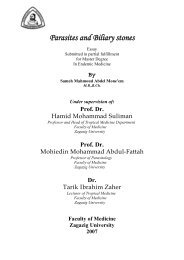J.'.~"";i'
J.'.~"";i'
J.'.~"";i'
You also want an ePaper? Increase the reach of your titles
YUMPU automatically turns print PDFs into web optimized ePapers that Google loves.
Review ofLiterature<br />
Management of pregnancy induced hypertension<br />
The most effective therapy for preeclampsia is delivery ofthe fetus and<br />
placenta in pregnancy at or near term in which the cervix is favorable<br />
labor should be induced in addition intravenous (IV) magnesieum sulfate<br />
(MgS04) should be used both during labor and postpartum to reduce the<br />
risk of convulsions. Disease severity and gestational age usually govern<br />
the decision to intervene and deliver a pareterm infant. (Abramovici and<br />
Sibai 1999).<br />
Mild Preeclampsia:<br />
All patients with mild preeclampsia should receive maternal and fetal<br />
evaluation at the time of their diagnosis .. Maternal evaluation includes<br />
measurements of blood pressure, weight, and urine protein, and<br />
questioning about symptoms of headache, visual disturbances and<br />
epigastric pain. Fetal evaluation should include ultrasonography to<br />
determine fetal growth and amniotic fluid volume, daily fetal movement<br />
count and nonsterss testing (or biophysical profile) at least once weekly<br />
(fig 1) (Abramovici and Sibai 1999).<br />
Laboratory evaluation includes determination of hematocrit,<br />
platelet counts every 2 days, and liver enzyme levels twice weekly. This<br />
evaluation is important since patients may develop thrombyctopenia and<br />
abnormal<br />
elevation.<br />
liver enzyme levels, even with minimal blood pressure<br />
Patients are instructed to receive a regular diet with no salt restriction and<br />
no restricted activity. Diuretics, antihypertensive drugs, and sedatives are<br />
not used .(Sibai , 1992).<br />
57
















